This pandan coconut jelly dessert with agar agar is a delightful and refreshing treat that combines layers of pandan flavors with a creamy coconut texture. It's a sweet and creamy delight you'll love with every bite!
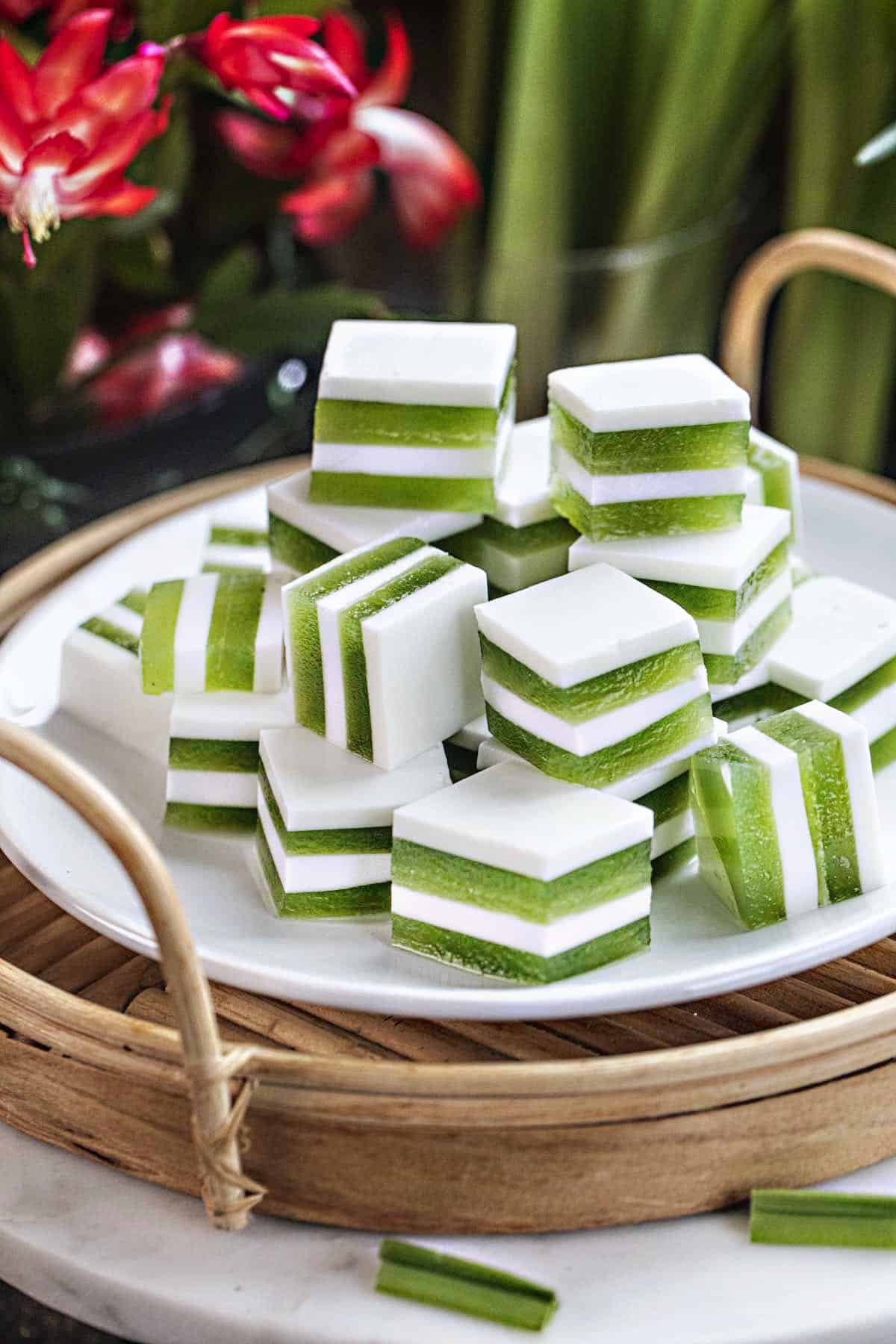
Learn about pandan and how to make pandan juice here. Also, make your own coconut milk using different methods. Even better, crack your own coconut here.
Jump to:
- What is Pandan Jelly Dessert?
- What is Pandan
- What is Agar Agar
- Why You'll Love Pandan Coconut Jelly
- Ingredients for Making Pandan Coconut Agar Jelly
- How to Make Pandan Coconut Jelly
- Tips for the Perfect Pandan Coconut Jelly
- Pandan Dessert Serving Tips
- Storage
- Other Pandan Recipes You May Like
- More Thai Recipes You Might Enjoy!
- Frequently Asked Questions
- Pandan Coconut Jelly
- Related
What is Pandan Jelly Dessert?
It's a popular jelly dessert using pandan juice and coconut milk to create multi-layer jelly. They are called agar agar jelly cake or wun gati bai tuey (วุ้นกะทิใบเตย).
What is Pandan
Pandan is a tropical plant with a unique flavor commonly used in many savory dishes and sweet Asian dishes. It is often called the "Asian vanilla" due to its aromatic and sweet taste.
What is Agar Agar
Agar Agar, on the other hand, is a jelly powder made from seaweed extract, and it's commonly used in Asian desserts, especially in agar agar jelly cakes. It often makes agar agar jelly cakes and other delightful Asian desserts.
It’s basically the same thing as gelatin powder but vegan.
Why You'll Love Pandan Coconut Jelly
- Amazing taste! Pandan's special flavor and aroma, mixed with creamy coconut, make a flavor that's hard to resist.
- Cooling and smooth. The jelly's smooth and firm texture makes it a satisfying treat, especially after enjoying a spicy Thai meal!
- Great for any occasion. Have it as a sweet treat after a delicious meal or as a refreshing snack whenever possible.
- Easy to make. This recipe is easy to make. It just takes some time to put it all together. But once you get going, it's quite easy to come together!
- Simple ingredients. Only a few ingredients are needed to make this fun and heavenly dessert!
Ingredients for Making Pandan Coconut Agar Jelly
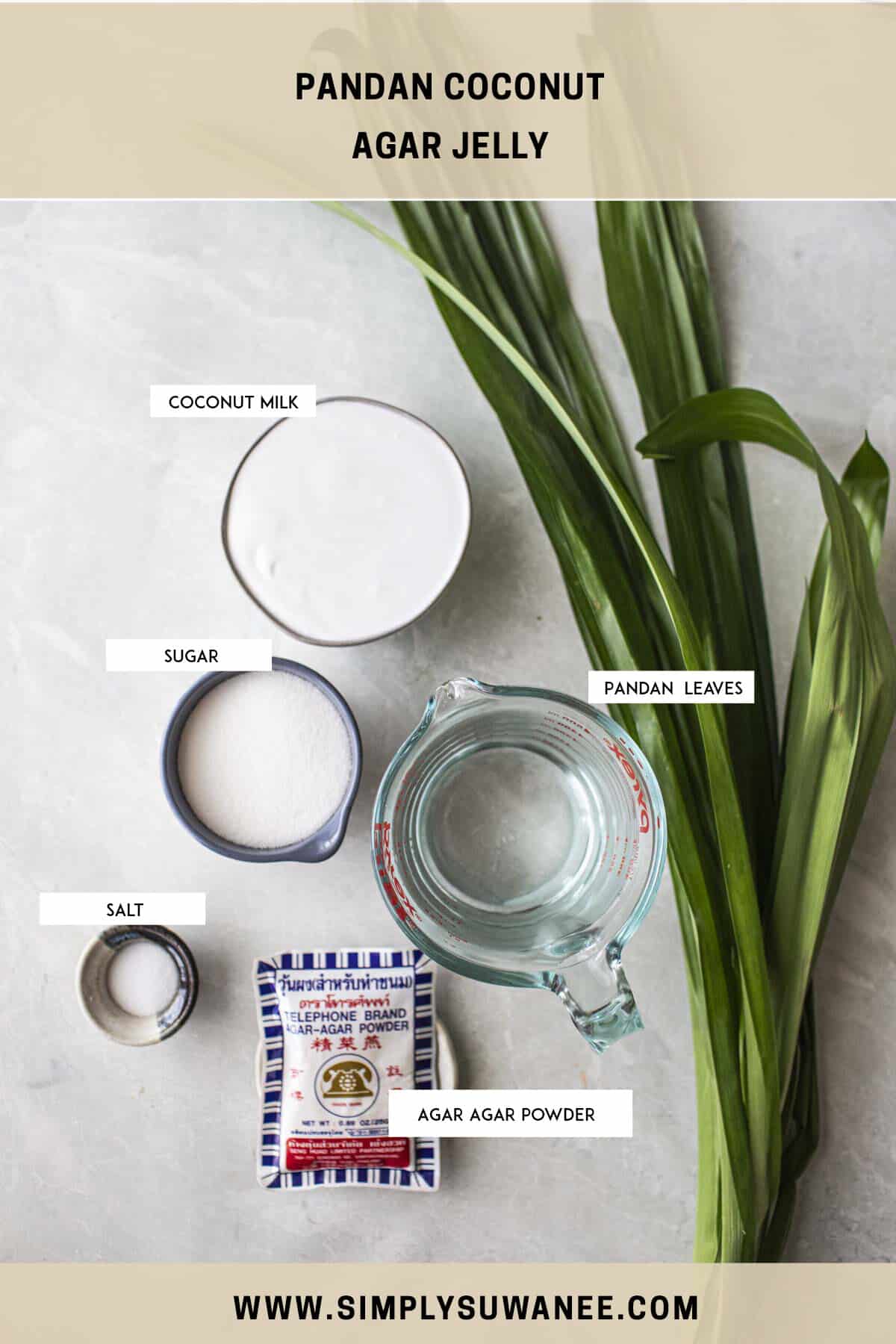
- Pandan water or juice. These are also called pandan juice. Pandan extract can be used. This is the main ingredient for this signature green color and pandan flavor. Find fresh or frozen leaves at most Asian supermarkets.
- Coconut milk. Adds creaminess and richness to the jelly. Coconut cream is too thick unless extra water is added to dilute it.
- Agar agar powder. A vegetarian alternative to gelatin for setting the jelly. These can be found at most Asian grocers.
- Water. Use coconut juice or coconut water from young coconuts for added coconut flavor and natural sweetness.
- White sugar. You want to use white sugar for this recipe. Palm or brown sugar will work, but your layers will be brown. If you agree, make a palm sugar syrup and enjoy it!
- Salt. Needs just a little bit to cut the sugar and also intensifies the coconut flavor.
How to Make Pandan Coconut Jelly
1. The pandan layer
This is the green layer of pandan gelatin we will be working on. The layers can be in any order of color you want, so have fun here! I chose to have green as the bottom layer.
1. Make the pandan juice. Make the pandan juice by chopping the pandan leaves into small pieces. Put in the food processor, add water, and blitz until you have a green pandan mixture.
Strain, and we will use this green goodness for our pandan layer.
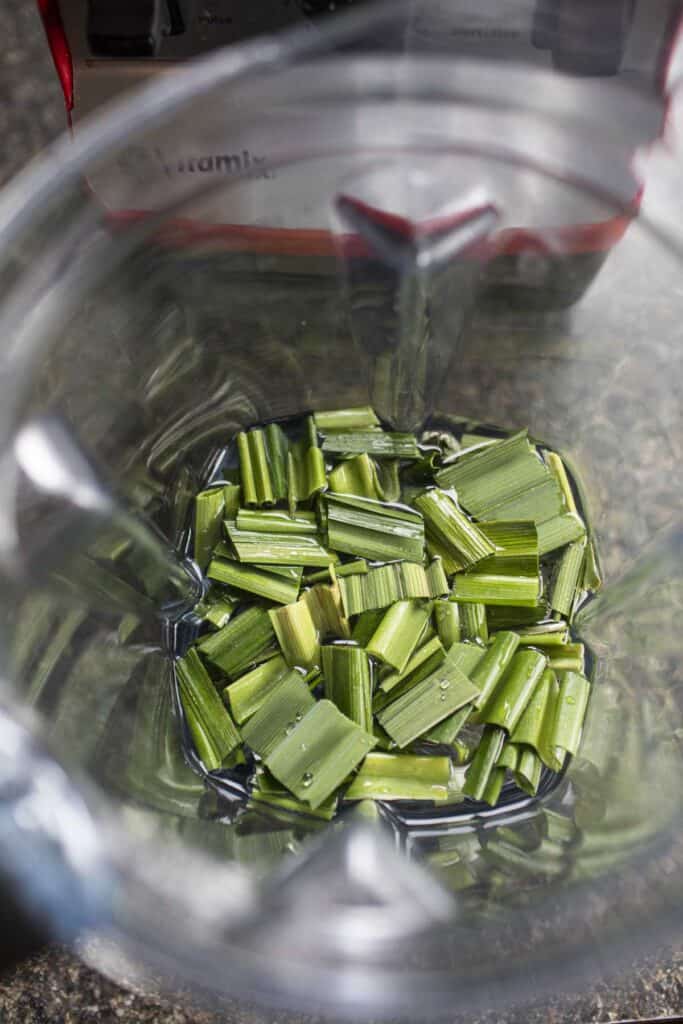
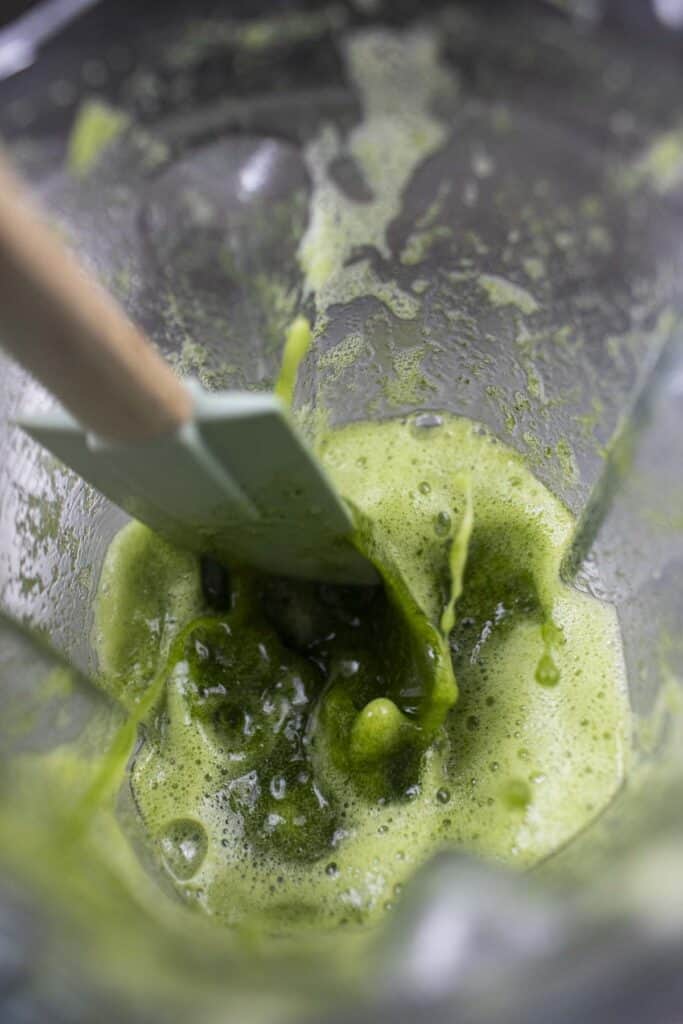
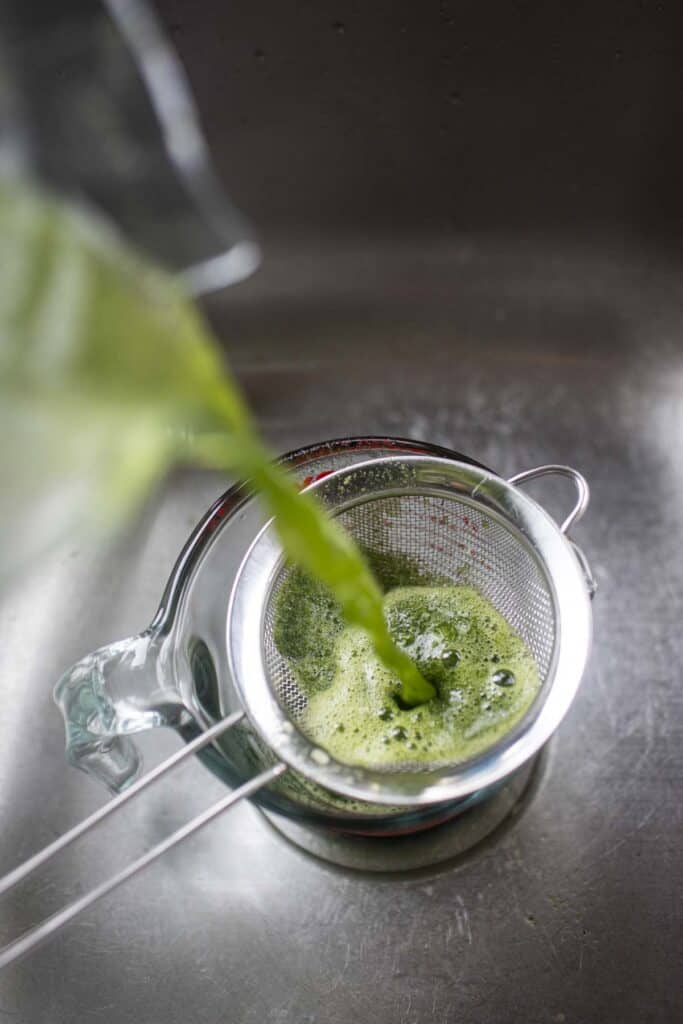
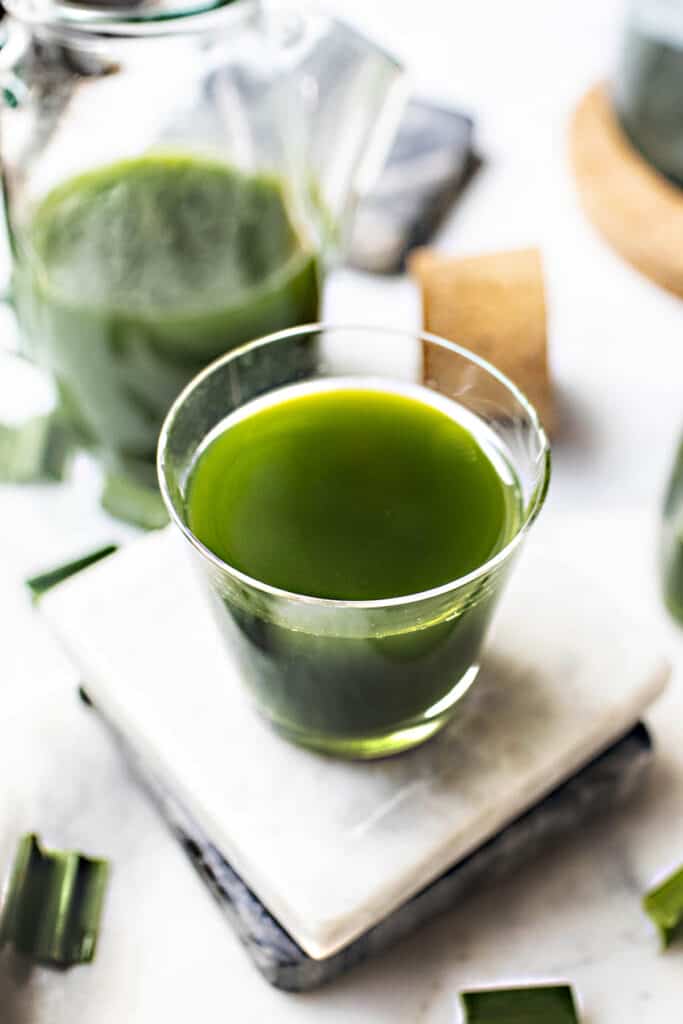
2. Make the agar water mixture. Add the agar agar powder to 1 cup of warm or hot water. Stir well until the tiny agar agar flakes are dissolved.
For best results, allow it to sit for 10-15 minutes before adding it to the coconut and pandan layer.
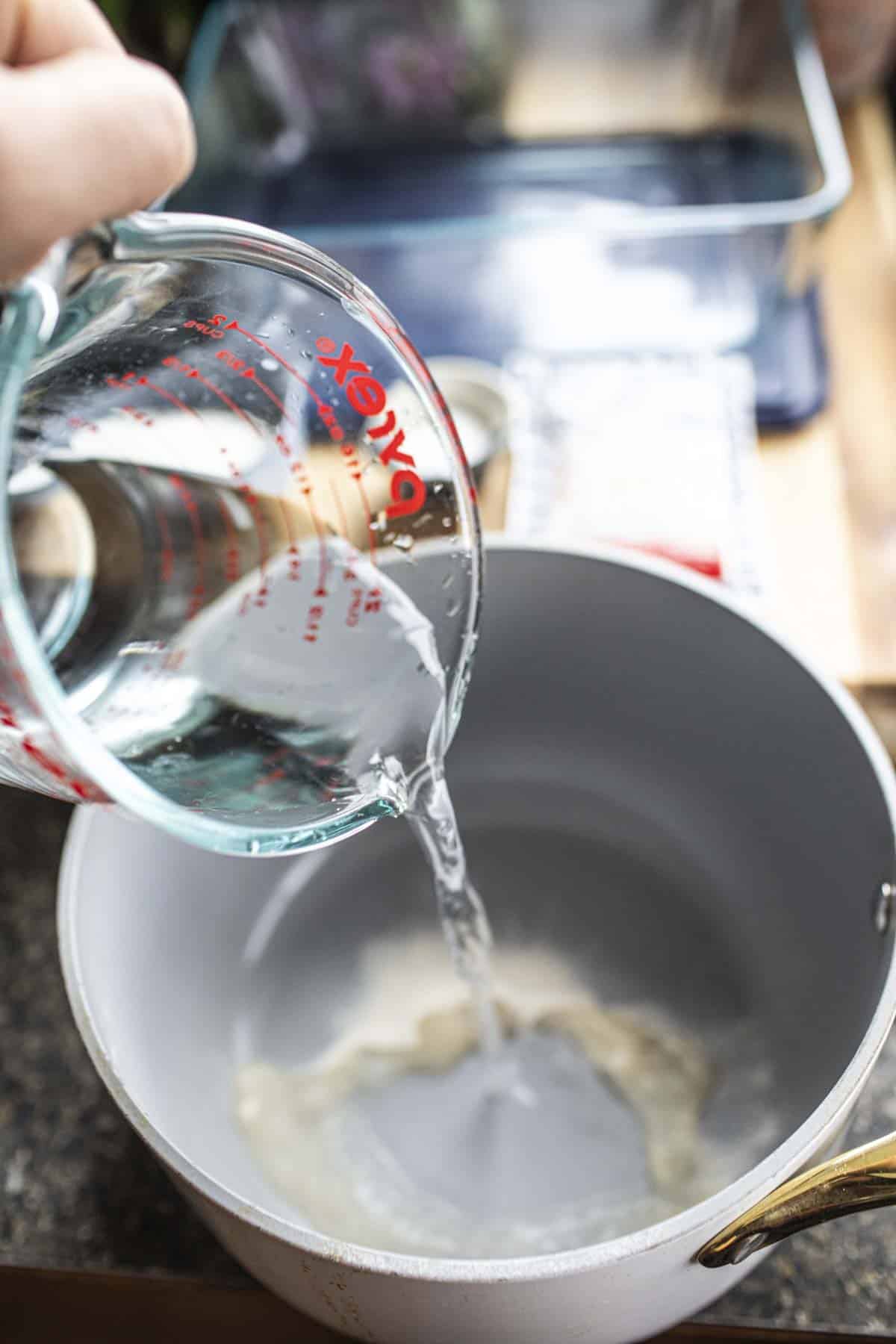
3. Make the sweet pandan syrup water. on medium heat, combine the pandan water, 1 cup of water, sugar, and salt in a gently boiled saucepan.
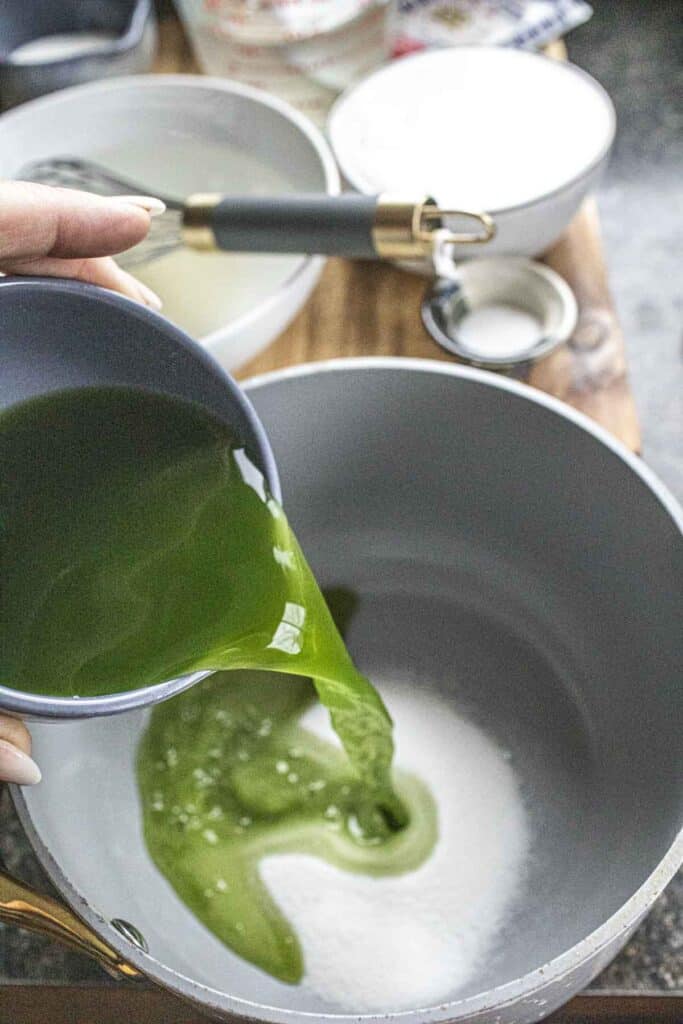
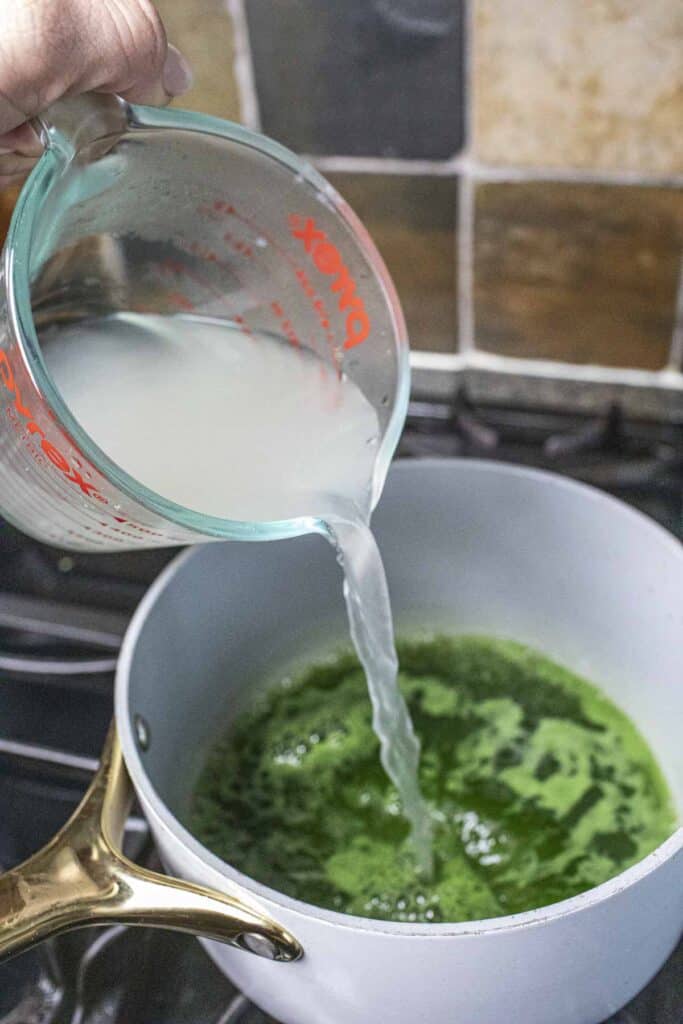
4. Add the agar water mixture to the pandan water. Do a quick whisk of the agar water to ensure all the deposits are stirred up.
5. Making the jelly mixture. Turn the heat low and stir until all the agar completely dissolves. Now, it's very important to keep the heat on very low.
Find the balance between keeping the syrupy water from boiling and letting it harden. The agar powder will set.
If the heat is not on, it will be hardened into a firm jelly texture. We want liquid, not jelly, at this stage.
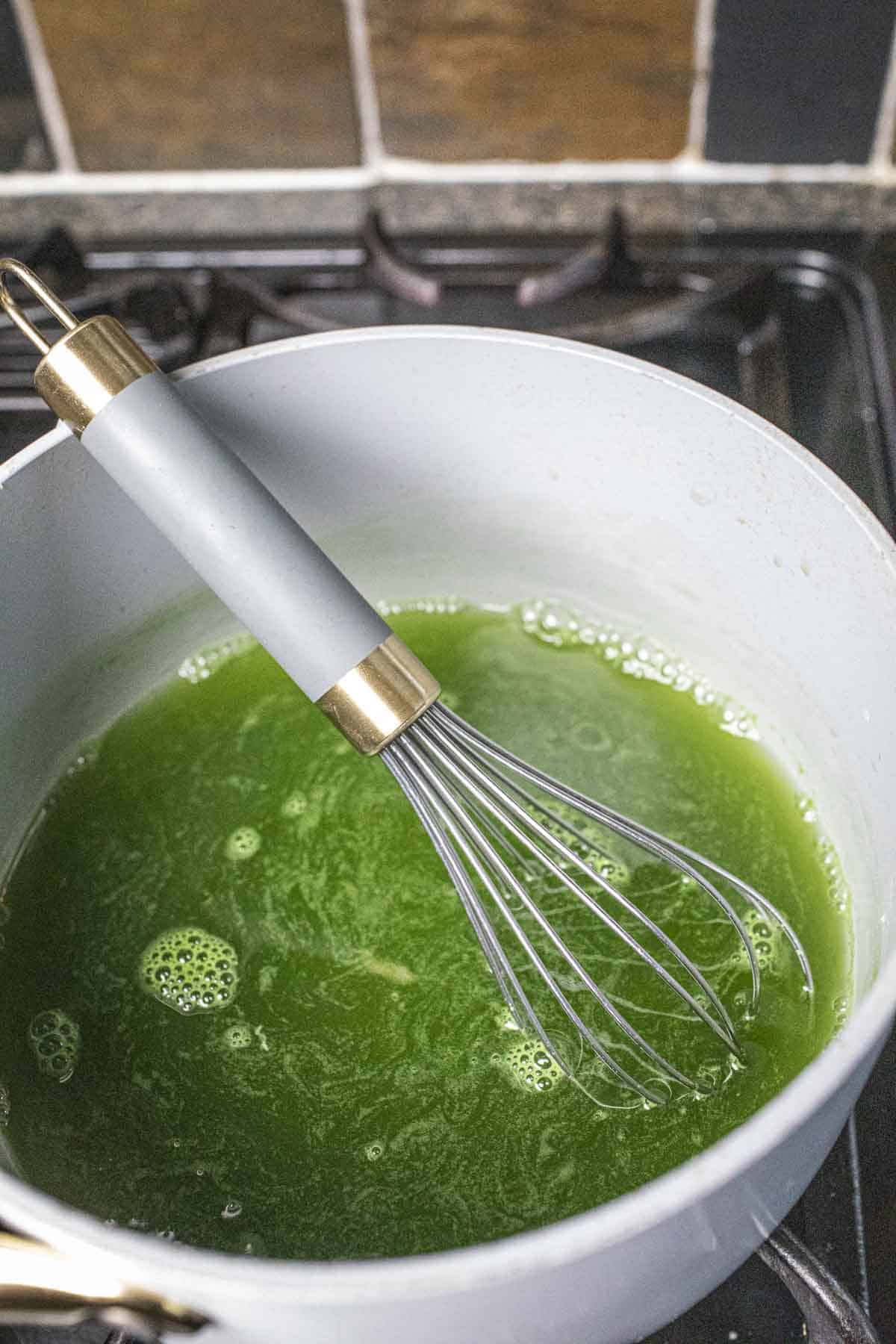
6. Pour and let it set. Slowly pour the sweet pandan layer into a heat-safe pan and allow it to cool and set. Use ⅓ of the liquid only and save the rest for different layers.
Put it in the fridge to speed up the cooling process. Now, let's move on to our coconut layer next.
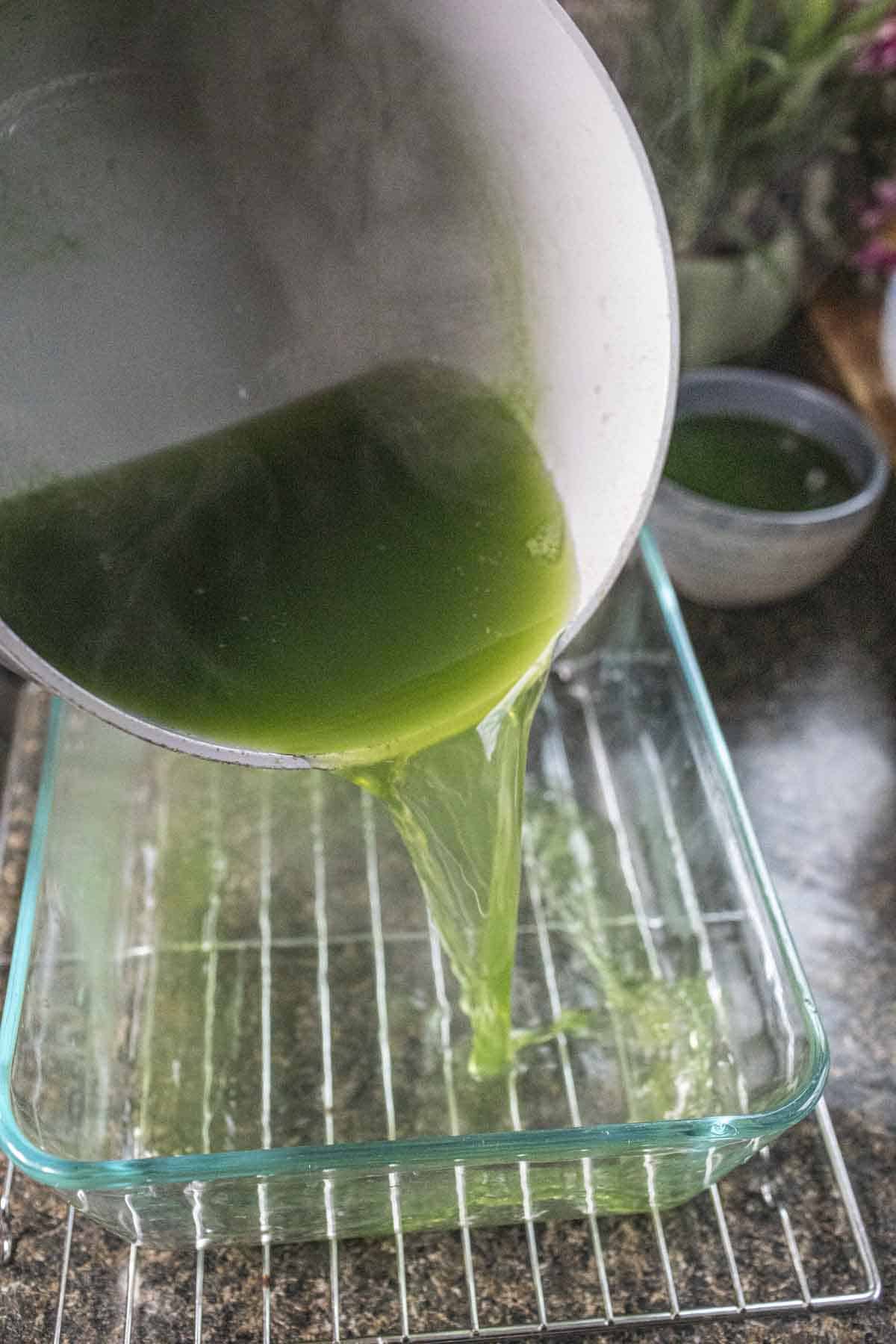
2. The Coconut Layer
This is the creamy white layer we will be working on. Use coconut milk for this part, and it's a little quicker than the pandan layer because we won't need to make the pandan juice first.
Make your own coconut milk with fresh coconut here.
1. Make the agar water mixture. The same as the step above. Add the agar powder to 1 cup of hot water, whisk well, and allow it to dissolve for 10-15 minutes.
2. Make the sweet coconut layer. Add coconut milk, 1 cup of water, sugar, and salt. Bring it to a gentle boil in a small saucepan.
Do not use high heat, or the coconut milk will curdle and can overcook it.
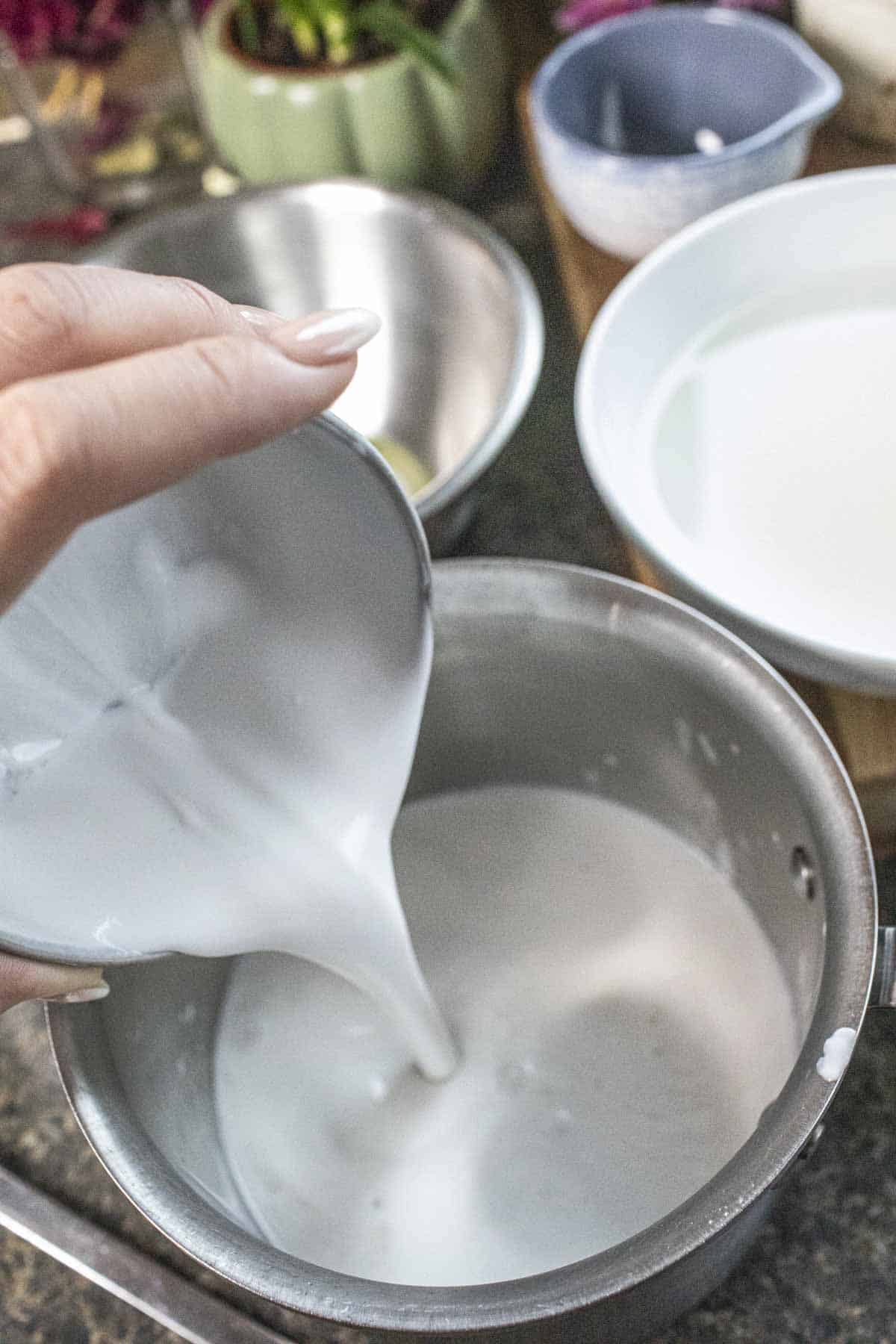
3. Make the sweet coconut mixture. Quickly whisk the agar solution to stir the deposit, then add it to the saucepan with the coconut mixture.
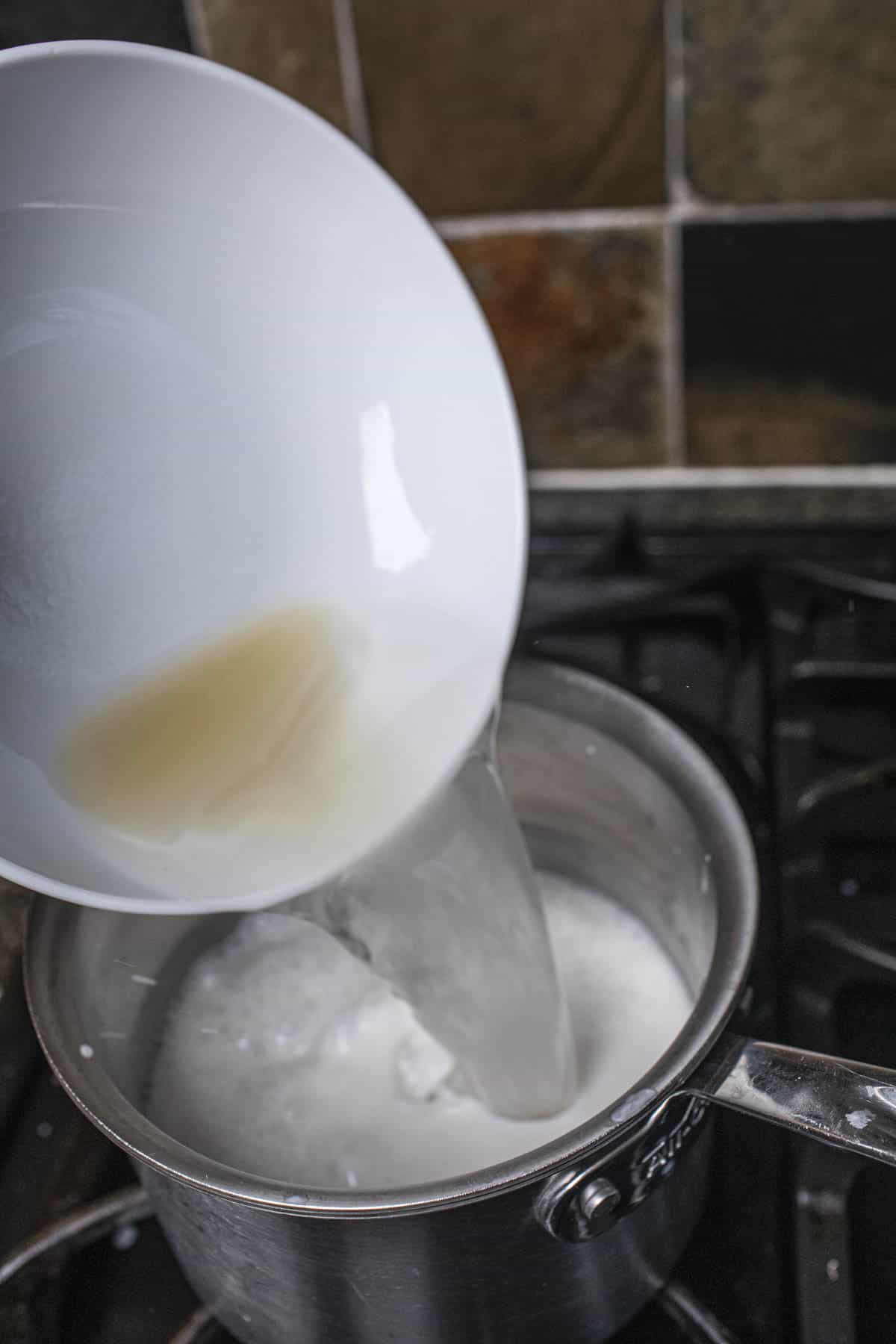
4. Turn the heat to low and stir until all the agar is completely dissolved. Then, turn the heat down to the lowest setting possible.
Don't let it boil, nor allow it to set into a jelly.
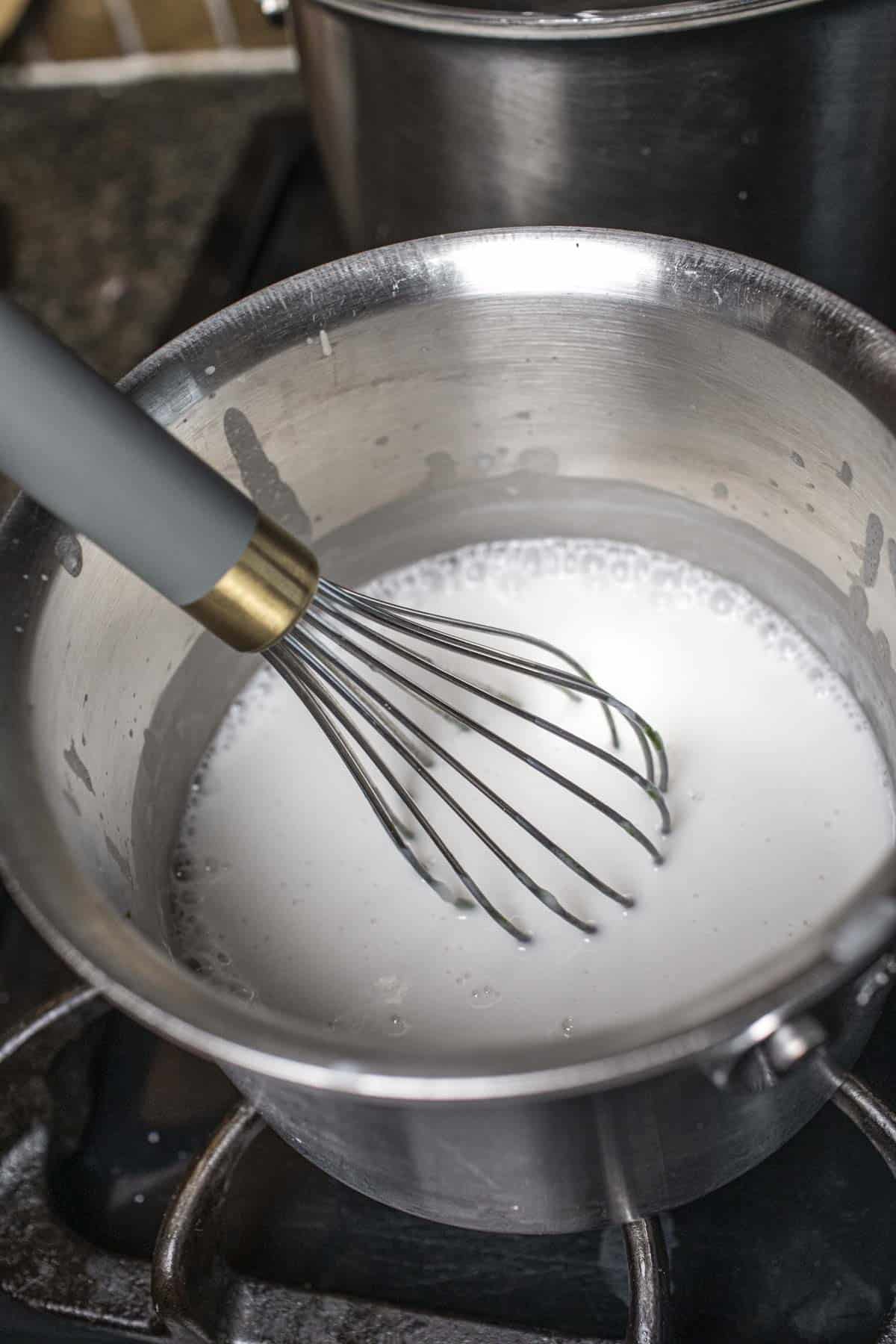
5. Pour the coconut layer. Make sure the pandan layer has hardened but not too hard, or the layers will not stick together. Carefully and gently pour a thin layer of the coconut syrup mixture over the pandan jelly.
Use only ⅓ of the amount of coconut. Save the rest for making more layers.
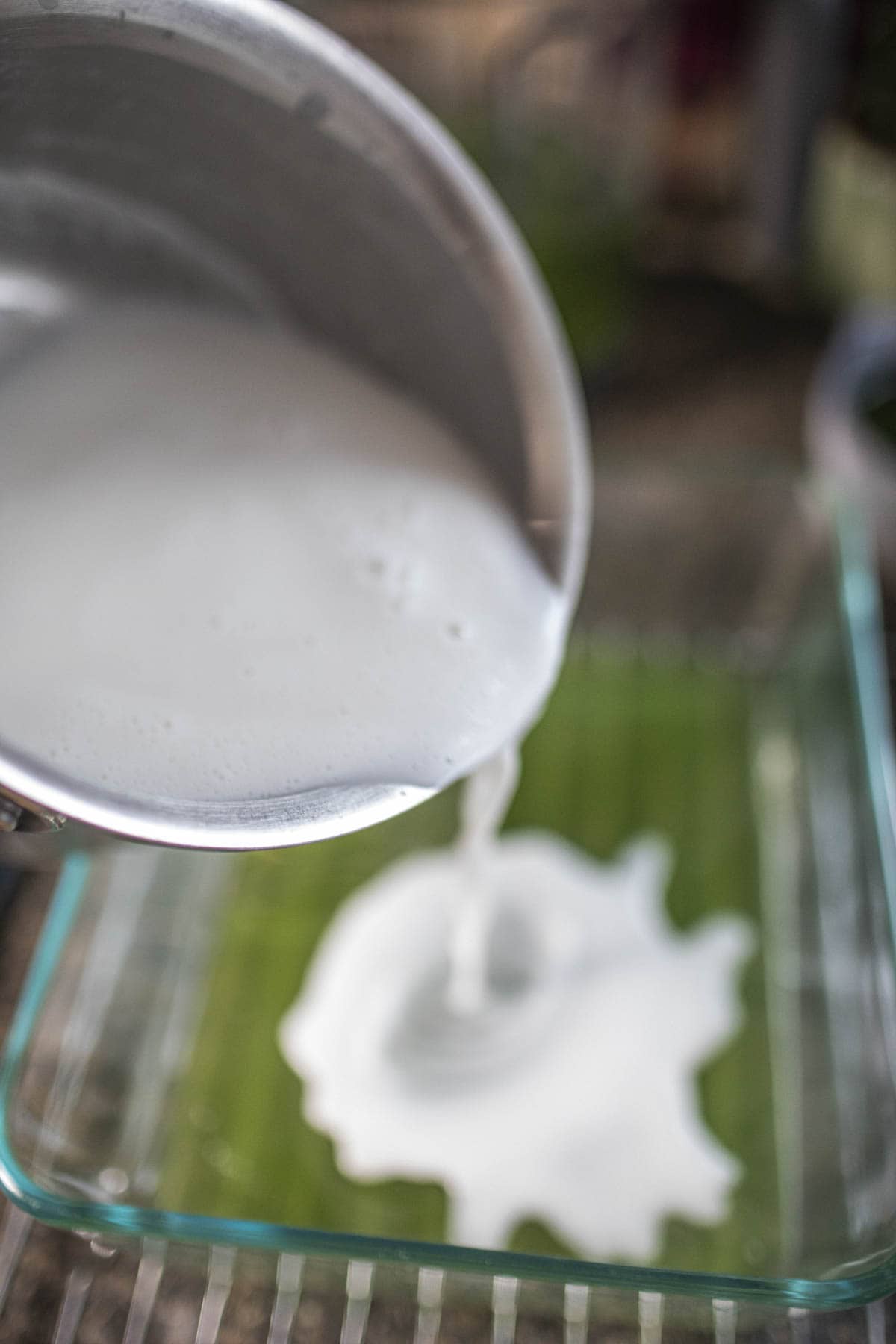
6. Repeat the layers. Repeat the cooling process as the pandan layer above, and keep going until you are out of your liquid!
The tricky part is the waiting time between setting and keeping the coconut and pandan syrup from setting or boiling.
7. Chill and serve! After you finish making all the layers, put the container in the fridge. If you leave it at room temperature, it will still be set but take longer.
Once it's set, your coconut-pandan jelly will be firm and ready to eat! Cut it into cubes and serve it cold.
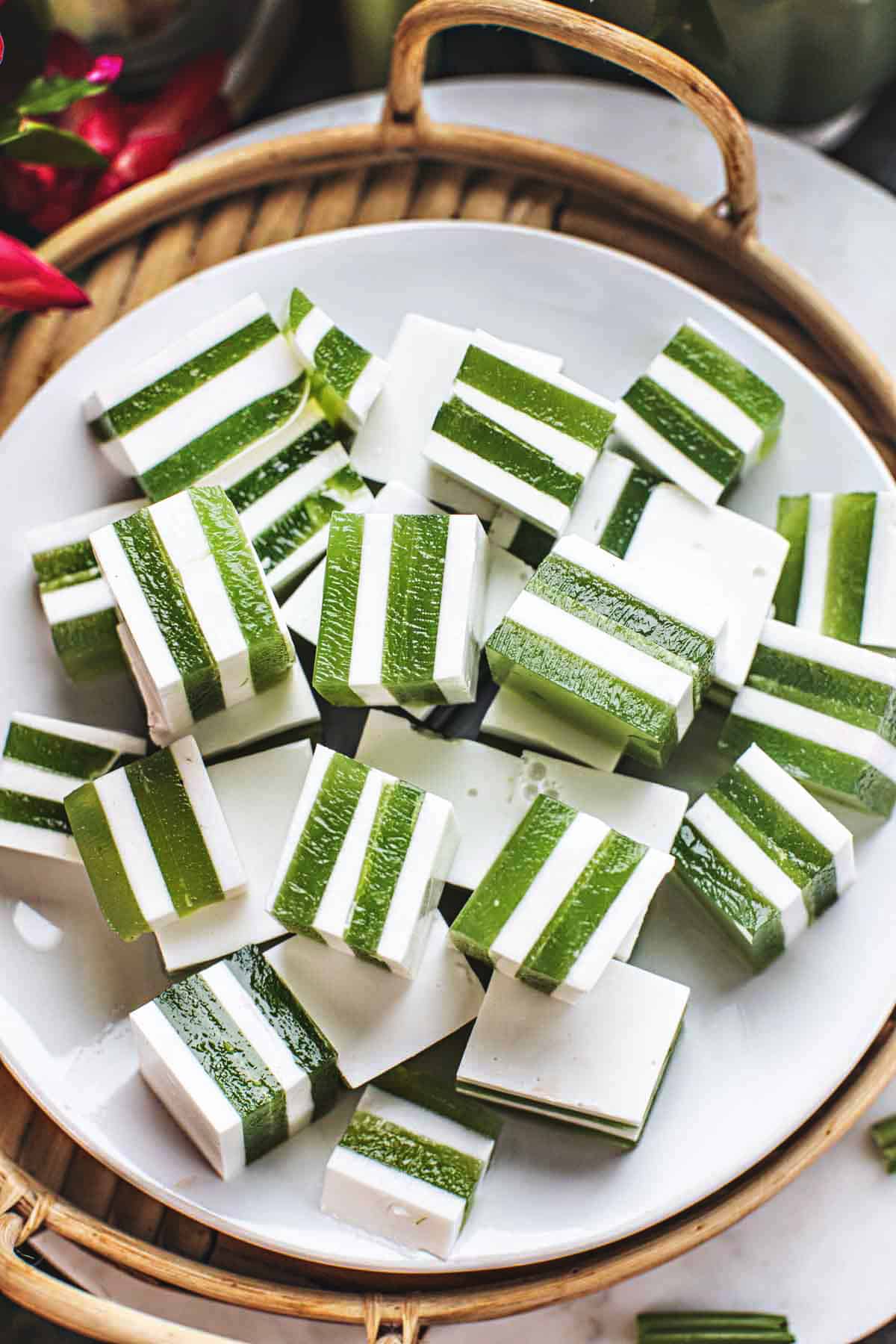
Have fun cutting it into any shape or size you want, especially if you have jelly molds. It's a fun activity to do with kids too. Enjoy!
Tips for the Perfect Pandan Coconut Jelly
- Getting the right consistency for the jelly layers is important. Make sure not to let the jelly set too long, or the layers will not stick together. Use your fingers to test and see if it is tender, not hard, but you still can't break through the layers with a firm press.
- Remember, whatever shape your pan is, the jelly mixture will mold into that shape. You can have fun here, too, by using different-shaped bowls or serving containers.
- When pouring hot syrup water into the jelly in a pan, the hot water can melt and tear the layer. Use a gentle hand and pour gentle help.
- You can also pick a corner spot where you use to pour the hot liquid on top of the jelly. I call it the "ugly corner," where the layers can tear and split in just one corner rather than in a few places and trim it out before serving. (:
- To speed up the jelly-setting process. Make an ice bath for your jelly container. Use a large bowl or pan that will fit the shape of your jelly pan and place it in the ice water to cool.
- It's ok to use canned pandan juice if you don't have access to fresh or frozen pandan. I used pandan leaves and then extracted them into juice for this recipe. You can use store-bought pandan water in a can found at the Asian markets.
- You can control the color of the pandan layer by adding more or less water to your pandan mixture when blending in the food processor.
- If cutting your own coconut, use the coconut meat to add the layers. The young coconut is especially delicious for this recipe!
Pandan Dessert Serving Tips
- Garnish with coconut shreds or pandan leaves for an elegant presentation.
- Use it with milk and enjoy it like creamy buko.
Storage
- Store leftover jelly in an airtight container in the refrigerator for up to 3 days.
Other Pandan Recipes You May Like
- Coconut mango sticky rice, a popular dessert that pandan is often used to flavor the dish
- Kabocha custard is a classic Thai dessert with a delicious taste
- Pandan Chiffon Cake
- Pandan Sticky Rice
More Thai Recipes You Might Enjoy!
- Glass jelly drink with brown sugar
- Sen Yai, homemade rice noodles using rice flour and water.
- Thai iced tea with tapioca pearls
- Mango pudding with sago pearls
Frequently Asked Questions
Allow each jelly layer to be partially set before adding the next layer to ensure even distribution.
Where Can I Buy Pandan Essence Pandan essence is available at Asian grocery stores or online retailers.
Ensure the agar agar powder is completely dissolved and the mixture is boiled for the recommended time.
Yes, pandan extract can be a convenient alternative to fresh pandan leaves. Adjust the quantity to taste.
Pandan is a unique ingredient, and substitution is not possible. However, you can use vanilla extract and green food coloring instead of pandan. But you will. Do not get the pandan flavor.
**Love a recipe you've tried? Please leave a 5-star rating in the recipe card below and a review in the comments section further down the page. Or follow me on social media at Facebook, Pinterest, or Instagram!**
Print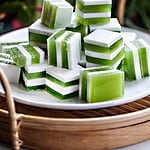
Pandan Coconut Jelly
- Total Time: 1 hour
- Yield: 10 servings
- Diet: Gluten Free
Description
This pandan coconut jelly dessert with agar agar is a delightful and refreshing treat that combines layers of pandan flavors with a creamy coconut texture. It's a sweet and creamy delight you'll love with every bite!
Ingredients
- 6 pandan leaves + 1 ¼ cup water to make 1 cup of green pandan water in the food processor.
- 1 can coconut milk. (13.5 ounces can)
- 4 teaspoons Agar agar powder. Divided, 2 teaspoons per color.
- 2 cups water, divided. Use one cup each to mix with agar powder for pandan layer and one cup for the coconut layer.
- ½ cup white sugar
- 1 teaspoon salt
* To make the sweet syrup mixture, we'll need 1 cup of pandan juice. I recommend adding a little extra water (about 1 ¼ cups) because after straining, you'll have slightly more than a cup of pandan juice. Keep in mind that pandan leaves are fibrous, so you might not end up with exactly 1 cup of pandan juice. Adding a little extra helps.
Instructions
This is the green layer of pandan gelatin we will be working on. The layers can be in any order of color you want, so have fun here! I chose to have green as the bottom layer.
1. Make the pandan juice. Make the pandan juice by chopping the pandan leaves into small pieces. Put in the food processor, add water, and blitz until you have a green pandan mixture. Strain, and we will use this green goodness for our pandan layer.
2. Make the agar water mixture. Add the agar agar powder to 1 cup of warm or hot water. Stir well until the tiny agar agar flakes are dissolved. For best results, allow it to sit for 10-15 minutes before adding it to the coconut and pandan layer.
3. Make the sweet pandan syrup water. on medium heat, combine the pandan water, 1 cup of water, sugar, and salt in a gently boiled saucepan.
4. Add the agar water mixture to the pandan water. Make sure to do a quick whisk of the agar water to ensure all the deposits are stirred up.
5. Making the jelly mixture. Turn the heat low and stir until all the agar completely dissolves. Now, it's very important to keep the heat on very low. Find the balance between keeping the syrupy water from boiling and letting it harden. The agar powder will set. If the heat is not on, it will be hardened into a firm jelly texture. We want liquid, not jelly, at this stage.
6. Pour and let it set. Slowly pour the sweet pandan layer into a heat-safe pan and allow it to cool and set. Use ⅓ of the liquid only and save the rest for different layers. Put it in the fridge to speed up the cooling process. Now let's move on to our coconut layer next.
This is the creamy white layer we will be working on. Use coconut milk for this part, and it's a little quicker than the pandan layer because we won't need to make the pandan juice first. See notes below for other options to use instead.
1. Make the agar water mixture. The same as the step above. Add the agar powder to 1 cup of hot water, whisk well, and allow it to dissolve for 10-15 minutes.
2. Make the sweet coconut layer. Add coconut milk, 1 cup of water, sugar, and salt, and bring it to a gentle boil in a small saucepan. Do not use high heat, or the coconut milk will curdle and can overcook it.
3. Make the sweet coconut mixture. Quickly whisk the agar solution to stir the deposit, then add it to the saucepan with the coconut mixture.
4. Turn the heat to low and stir until all the agar is completely dissolved. Then turn the heat down to the lowest setting possible. Don't let it boil, nor allow it to set into a jelly.
5. Pour the coconut layer. Make sure the pandan layer has hardened but not too hard, or the layers will not stick together. Carefully and gently pour a thin layer of the coconut syrup mixture over the pandan jelly. Use only ⅓ of the amount of coconut. Save the rest for making more layers.
6. Repeat the layers. Repeat the cooling process as the pandan layer above, and keep going until you are out of your liquid! The tricky part is the waiting time between setting and keeping the coconut and pandan syrup from setting or boiling.
7. Chill and serve! After you finish making all the layers, put the container in the fridge. If you leave it at room temperature, it will still set but take a bit longer. Once it's set, your coconut-pandan jelly will be firm and ready to eat! Cut it into cubes and serve it cold.
Have fun cutting it into any shape or size you want, especially if you have jelly molds. It's a fun activity to do with kids too. Enjoy!
Notes
- Getting the right consistency for the jelly layers is important. Make sure not to let the jelly set too long, or the layers will not stick together. Use your fingers to test and see if it is tender, not hard, but you still can't break through the layers with a firm press.
- Remember, whatever shape your pan is, the jelly mixture will mold into that shape. You can have fun here, too, by using different-shaped bowls or serving containers.
- When pouring hot syrup water into the jelly in a pan, the hot water can melt and tear the layer. Use a gentle hand and pour gentle help.
- You can also pick a corner spot where you use to pour the hot liquid on top of the jelly. I call it the "ugly corner," where the layers can tear and split in just one corner rather than in a few places and trim it out before serving. (:
- To speed up the jelly-setting process. Make an ice bath for your jelly container. Use a large bowl or pan that will fit the shape of your jelly pan and place it in the ice water to cool.
- It's ok to use canned pandan juice if you don't have access to fresh or frozen pandan. I used pandan leaves and then extracted them into juice for this recipe. You can use store-bought pandan water in a can found at the Asian markets.
- You can control the color of the pandan layer by adding more or less water to your pandan mixture when blending in the food processor.
- If cutting your own coconut, use the coconut meat to add the layers. The young coconut is especially delicious for this recipe!
- Prep Time: 10
- Cook Time: 50
- Category: Dessert
- Method: Stovetop
- Cuisine: Thai
** Thank you so much for visiting my blog! This is truly a passion for me. If you have enjoyed these recipes and appreciate the hard work I put into them, I would love it if you would share them with your friends! Your recommendation is the highest review I could hope for, and I’d appreciate it! **
Related
Looking for other recipes like this? Try these.





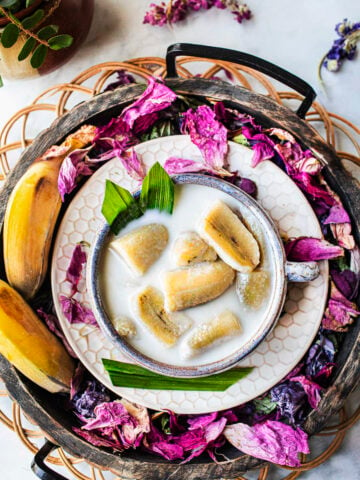
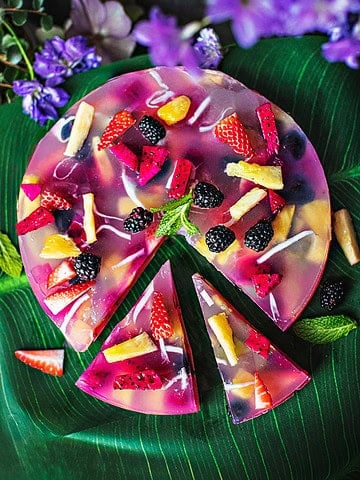
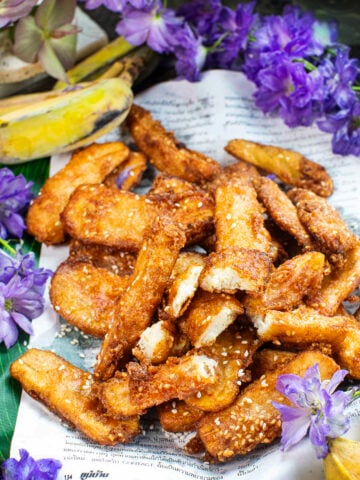
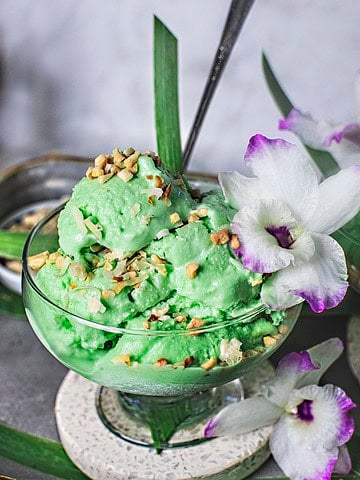
Wara says
This recipe was super easy and turned out delicious! Loved how quick it was to prepare and the flavors were amazing. Thank you for your sharing.